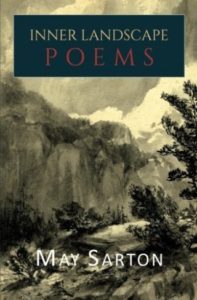The Art of Being Alone: May Sarton’s Stunning 1938 Ode to Solitude
INSPIRATIONAL, 20 May 2019
Maria Popova | Brain Pickings – TRANSCEND Media Service
“There is no place more intimate than the spirit alone.”
 “The best things in life happen to you when you’re alone,” artist Agnes Martin reflected in her final years. “Oh comforting solitude, how favorable thou art to original thought!” wrote the founding father of neuroscience in his advice to young scientists. The poet Elizabeth Bishop believed that everyone should experience at least one prolonged period of solitude in life. For in true solitude, as Wendell Berry so memorably observed, “one’s inner voices become audible [and] in consequence, one responds more clearly to other lives” — an intuitive understanding of what psychologists have since found: that “fertile solitude” is the basic unit of a full and contented life.
“The best things in life happen to you when you’re alone,” artist Agnes Martin reflected in her final years. “Oh comforting solitude, how favorable thou art to original thought!” wrote the founding father of neuroscience in his advice to young scientists. The poet Elizabeth Bishop believed that everyone should experience at least one prolonged period of solitude in life. For in true solitude, as Wendell Berry so memorably observed, “one’s inner voices become audible [and] in consequence, one responds more clearly to other lives” — an intuitive understanding of what psychologists have since found: that “fertile solitude” is the basic unit of a full and contented life.
But in the neutral state of aloneness, the psychoemotional line between solitude and loneliness can be as thin as a razor’s edge and as lacerating to the soul. How to draw it skillfully in orienting ourselves to the world, exterior and interior, is what poet, novelist, and memoirist May Sarton (May 3, 1912–July 16, 1995) explores in a beautiful poem she penned ten days after her twenty-sixth birthday, decades before she came to contemplate solitude in stunning prose. Originally titled “Considerations,” the poem was slightly revised and published the following year as “Canticle 6” in Sarton’s second poetry collection, the altogether sublime Inner Landscape (public library).
CANTICLE 6
by May Sarton
Alone one is never lonely: the spirit
adventures, waking
In a quiet garden, in a cool house, abiding single there;
The spirit adventures in sleep, the sweet thirst-slaking
When only the moon’s reflection touches the wild hair.
There is no place more intimate than the spirit alone:
It finds a lovely certainty in the evening and the morning.
It is only where two have come together bone against bone
That those alonenesses take place, when, without warning
The sky opens over their heads to an infinite hole in space;
It is only turning at night to a lover that one learns
He is set apart like a star forever and that sleeping face
(For whom the heart has cried, for whom the frail hand burns)
Is swung out in the night alone, so luminous and still,
The waking spirit attends, the loving spirit gazes
Without communion, without touch, and comes to know at last
Out of a silence only and never when the body blazes
That love is present, that always burns alone, however steadfast.
******
Complement with Louise Bourgeois on how solitude enriches creative work, Virginia Woolf on the relationship between loneliness and creativity, and Olivia Laing’s masterwork on the art of being alone, then revisit other readings of beautiful poems of existential radiance: Derek Walcott’s “Love After Love,” Wisława Szymborska’s “Life-While-You-Wait,” Jane Kenyon’s “Having It Out With Melancholy,” and Adrienne Rich’s “Planetarium.”
_______________________________________
 Brain Pickings is the brain child of Maria Popova, an interestingness hunter-gatherer and curious mind at large obsessed with combinatorial creativity who also writes for Wired UK and The Atlantic, among others, and is an MIT Futures of Entertainment Fellow. She has gotten occasional help from a handful of guest contributors. Email: brainpicker@brainpickings.org
Brain Pickings is the brain child of Maria Popova, an interestingness hunter-gatherer and curious mind at large obsessed with combinatorial creativity who also writes for Wired UK and The Atlantic, among others, and is an MIT Futures of Entertainment Fellow. She has gotten occasional help from a handful of guest contributors. Email: brainpicker@brainpickings.org
Go to Original – brainpickings.org
Tags: Literature, Psychology
DISCLAIMER: The statements, views and opinions expressed in pieces republished here are solely those of the authors and do not necessarily represent those of TMS. In accordance with title 17 U.S.C. section 107, this material is distributed without profit to those who have expressed a prior interest in receiving the included information for research and educational purposes. TMS has no affiliation whatsoever with the originator of this article nor is TMS endorsed or sponsored by the originator. “GO TO ORIGINAL” links are provided as a convenience to our readers and allow for verification of authenticity. However, as originating pages are often updated by their originating host sites, the versions posted may not match the versions our readers view when clicking the “GO TO ORIGINAL” links. This site contains copyrighted material the use of which has not always been specifically authorized by the copyright owner. We are making such material available in our efforts to advance understanding of environmental, political, human rights, economic, democracy, scientific, and social justice issues, etc. We believe this constitutes a ‘fair use’ of any such copyrighted material as provided for in section 107 of the US Copyright Law. In accordance with Title 17 U.S.C. Section 107, the material on this site is distributed without profit to those who have expressed a prior interest in receiving the included information for research and educational purposes. For more information go to: http://www.law.cornell.edu/uscode/17/107.shtml. If you wish to use copyrighted material from this site for purposes of your own that go beyond ‘fair use’, you must obtain permission from the copyright owner.